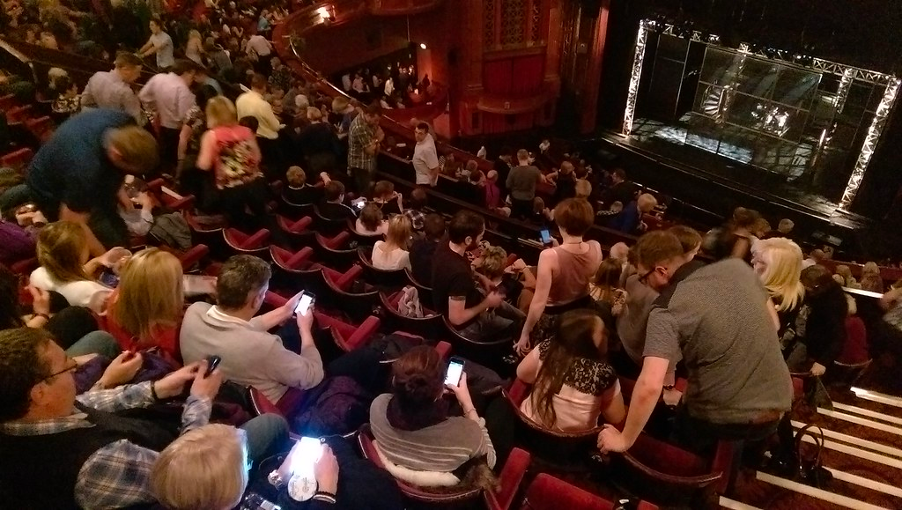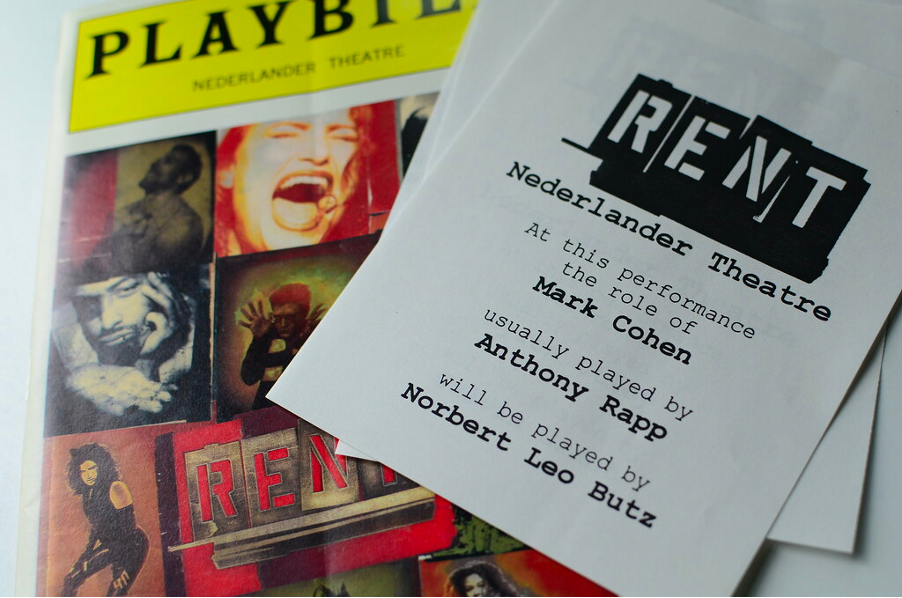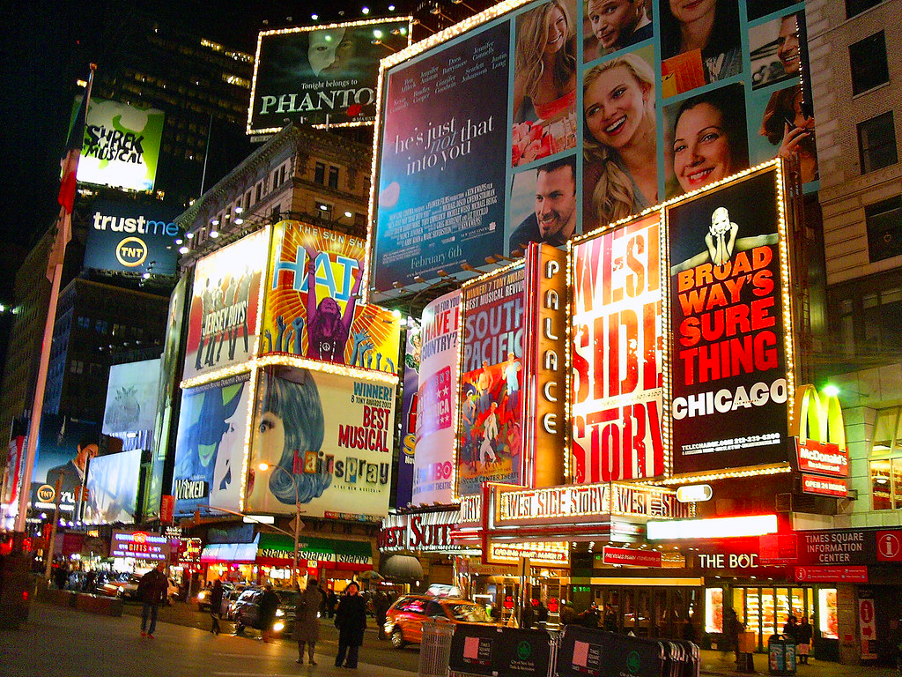
“Mobile Phones at Theatre Interval” by david-gilmour is licensed under CC BY-NC-SA 2.0.
Spoiler alert: they’re here to stay.
The internet war between producers and the people is a narrative familiar to most of us. It is no wonder why many fans find their creativity discouraged and existences vindicated. After all, the typical framing of the internet’s sharing culture – where users participate in environments with a supposed “absence of hierarchy and a sense of egalitarianism” (John, 2016, p. lxviii) – is frequently villainised by the policies of corporations and governments through “metaphors of war and terrorism” (Chelberg, 2021, 62). While much scholarship is understandably more sympathetic towards users than corporations (Brøvig-Hanssen, 2023; Kunze, 2023; Freund, 2014), it is not helpful to constantly paint copyright moderation as a black-and-white situation. Other factors are at play, as the world of musical bootlegs will convey.
What are musical bootlegs?

Bootlegs are illegal recordings of performances that are either publicly distributed via YouTube and similar file-sharing services or traded within more exclusive groups. Unlike where sharing television or music does not compromise quality (Freund, 2014, p. 1350), the graininess of bootlegs and the nature of live performance make it impossible for algorithms to moderate. YouTube’s Content ID system requires “copyright holders to provide to provide YouTube with reference files of their copyrighted works” to compare to videos (Edwards, 2018, p. 65). That system does not work with a medium performed by different people and sets. So, bootlegs could only be taken down if noticed by creators.
Even if we ever pass that barrier, there are several techniques fans use to mitigate promotion by the algorithm, like discouraging interaction in comments and the like-dislike ratio or making their video titles unclear as to what the content consists of.
For fans, bootlegging has made Broadway more accessible than before. While not reflective of this current year, the Broadway League (2019, p. 5) noted that from among the audience:
- 65% of tickets were from tourists, primarily non-New Yorker Americans.
- 81% of theatregoers above age 24 have completed tertiary study. 41% had earned a graduate degree.
- The average annual household income of theatregoers was $261,000, above the 2019 New Yorker median household income of $71,860 (Federal Reserve Economic Data, n.d.).
- While having reached a record high of non-Caucasian attendance, 74% were Whites.

It is a very different demographic from the online musical fandom due to the internet decentralising communication internationally (Benkler, 2006, p. 30). This international community must rely on the chance of being able to afford the theatre when musicals tour their country. These musicals, however, tend to be Broadway hits. A quick peruse of what musicals are playing in Sydney sees Disney’s Beauty and the Beast (1993), Grease (1971), Chicago (1975), Miss Saigon (1989), Wicked (2003), and the jukebox musical Tina (2018). So, the access to niche musicals beyond their original runs wholly depends on bootlegs.
The popularity of bootlegs on social media has contributed to the success of some musicals. Heathers (2014) – an adaptation of the 1989 teen black comedy film – has “enjoyed considerable cult status since its … off-Broadway debut … in robust fandoms across … Tumblr … YouTube [and] TikTok” (Boffone, 2021, p. 180). Their viral clips and trends circulate from their official soundtrack or bootlegs (Boffone, 2021, p. 181). Its popularity saw Heathers’ eventual West End run in 2018 and the casting of Carrie Hope Fletcher – an actress with an online teenage girl fanbase (Boynton, 2018, p. 214) – in the leading role.
On the other hand, SIX (2017) – a reimaging of Henry VIII’s six wives as a girl band – encourages audiences to record and share their final song on social media, as if an actual concert. These two musicals use unofficial fan recordings as their marketing, successfully reaching their targeted fanbases (Bouffone, 2021). However, their innovative incorporation of bootlegs cannot suit all musicals with different tones, fanbases and subjects. And, of course, there’s one issue that plagues all art.
We Live In A Capitalist Society
In a Tumblr post, Lin-Manuel Miranda (2015), composer of the critically acclaimed Hamilton, advocated against the use of bootlegs:
Responses to Miranda were mixed, though Harperhug (2016) best encapsulates the opinions of bootleg supporters:
You cannot simultaneously claim to represent the story of a country AND keep that story unavailable for the vast majority of people in that country. Either make your product actually accessible or understand that people who do not have access will get access in ways you don’t expect or approve of.
#class privilege is oozing out of my ears
While one could describe these users entitled and impatient and mourn for the era before on-demand entertainment (Bruun, 2019, p. 97-98), this divide between producer and consumer stems from ignorance towards the theatre business. Musicals have upfront costs of US$10-20 million, and the added costs of salaries, renting, advertising, maintenance of equipment, and royalties “could easily total $200k a week and often $500k+” (Dent, 2021). It has led to an estimated “80% of producers and investors [struggling] to recoup their investments” (Dent, 2021). Due to theatre’s limited capacity, shows could never meet supply and demand issues that music and television could achieve. So, Lin-Manuel Miranda’s concerns are understandable, and the pro-shot (the official recording of a performance) was eventually streamed on Disney+.
While not the first pro-shot of a musical released, “app downloads for Disney+ … were up 74% over the weekend of Hamilton’s release as compared with weekends in June”, and the film “had the largest audience over the course of a month of any streaming program” at the time of writing (Durkee, 2020). This financial success suggests that pro-shots are a viable method for musicals to meet the demand from those not part of its typical demographic. It has immortalised their cast’s performances for eternity. Musicals can finally be a medium easily shared, just like television and music.
Problem Solved?
Unfortunately, pro-shots are more expensive than their shows. Kulak (2022) notes that for investors, “to capture a Broadway production costs 5 to 10 times to” overseas productions. The costs of filming and contract requirements under the Screen Actors Guild put the onus on theatre fans – a very niche market – to recoup the costs (Kulak, 2022).
It is why existing pro-shots are associated with the traditional media, like Into the Woods (1989) with PBS, Cats (1998) with the now-defunct PolyGram Video, Legally Blonde (2007) and MTV, SpongeBob SquarePants (2019) with Nickelodeon, and Hamilton (2020) and Disney. So, the archival and circulation of smaller musicals and particular cast performances still depend on fan recordings. Even shows with good quality pro-shots will still have bootlegs circulating due to user independency. Regardless of morals, users will find a way to bypass moderation through alternative websites and channels (Brøvig-Hanssen and Jones, 2023, p. 1279), as is the nature of Web 2.0.
So, where are we now?
Back to Square One
Bootlegs are here to stay.
Reference List
Benkler, Y. (2008). The networked information economy. In The Wealth of Networks: How Social Production Transforms Markets and Freedom (pp. 29-128). Yale University Press. https://doi.org/10.12987/9780300127232.
Boffone, T. (2021). From Heathers to Six: Stealth musicals and the TikTok Broadway archive. Studies in musical theatre, 15(3), 175-189. https://doi.org/10.1386/smt_00070_1.
Boynton, P. (2016). Keep calm and Carrie on. Lancet Psychiatry, 3(3), 214-214. https://doi.org/10.1016/S2215-0366(16)00059-6.
Brøvig-Hanssen, R., & Jones, E. (2023). Remix’s retreat? Content moderation, copyright law and mashup music. New media & society, 25(6), 1271-1289. https://doi.org/10.1177/14614448211026059.
Bruun, H. (2019). The delay economy of “continuity” and the emerging impstience culture of the digital era. Nordic journal of media studies, 1(1), 85-101. https://doi.org/10.2478/njms-2019-0006.
Chelberg, K. (2021). ‘Sharing is caring’: Copyright metaphors and online sharing norms. Law, technology and humans, 3(2), 61-75. https://doi.org/10.5204/lthj.1271.
Dent, M. (2021, November 20). The economics of Broadway shows. The Hustle. https://thehustle.co/the-economics-of-broadway-shows/.
Durkee, A. (2020, August 10). ‘Hamilton’ Boosts A Struggling Disney As Broadcast Dominated Streaming Platforms in July. Forbes. https://www.forbes.com/sites/alisondurkee/2020/08/10/hamilton-boosts-a-struggling-disney-as-broadcast-dominated-streaming-platforms-in-july.
Edwards, D.W. (2018). Circulation gatekeepers: Unbundling the platform politics of YouTube’s Content ID. Computers and composition, 47(6), 61-74. https://doi.org/10.1016/j.compcom.2017.12.001.
Federal Reserve Economic Data. (n.d.). Median household income in New York. https://fred.stlouisfed.org/series/MEHOINUSNYA646N.
Freund, K. (2016). “Fair use is legal use”: Copyright negotiations and strategies in the fan-vidding community. New media & society, 18(7), 1347-1363. https://doi.org/10.1177/1461444814555952.
Gil Estevam. (2018, November 29). Legally Blonde the Musical (Pro-shot MTV). [Video]. YouTube. https://www.youtube.com/watch?v=RiX-EJA8n4w.
Harperhug. (2016, September 9). Wait, this is the comeback? [Blog post]. Tumblr. https://www.tumblr.com/harperhug/150162174600/wholivesdiestellsyourstory-linmanuel.
John, N.A. (2016). Sharing economies. In The Age of Sharing (pp. lviii-lxxvii). Polity Press.
Kulak, A. (2022, August 16). The unexpected paywall of proshots. [Blog post]. OnStage Blog. https://www.onstageblog.com/editorials/2022/8/16/the-unexpected-paywall-of-proshots.
Kunze, P.C. (2023). Bootlegs over Broadway: musical theatre (re)productions, digital circulation, and the informal media economy. Creative industries journal, 16(2), 204-221. https://doi.org/10.1080/17510694.2021.1996984.
LincolnCenterTheatre. (2017, May 20). Sneak Peak! FALSETTOS on Live from Lincoln Center. [Video]. YouTube. https://www.youtube.com/watch?v=ZjnAHOdMQVk.
Linmanuel. (2015, March 27). Oh, I’ve caused a shitstorm. [Blog post]. Tumblr. https://linmanuel.tumblr.com/post/114774696985/lovesjustachemical-actressingfanatic.
Special_Effect. (2014, October 2). Into the Woods. [Video]. YouTube. https://www.youtube.com/watch?v=kqCsQCsinK4.
SpongeBob SquarePants Official. (2020, January 2). ‘Bikini Bottom Day’, ‘Super Sea Star Savior’, & ‘Best Day Ever’ from The SpongeBob Musical Live!’. [Video]. YouTube. https://www.youtube.com/watch?v=hU9yGHBUtpY.
Sydney.com. (n.d.). Musicals & operas. Retrieved September 29, 2020, https://www.sydney.com/things-to-do/arts-and-culture/musicals?gclid=CjwKCAjwseSoBhBXEiwA9iZtxgaXARSyNM8YgRKSrFZVqO5Q8cH8kOcJX9Q4tBBmrYRARslvTPNXMRoCQbsQAvD_BwE&gclsrc=aw.ds.
The Broadway League. (2019, November). The demographics of the broadway audience 2018-2019. http://pocholiving.com/wp-content/uploads/2020/09/Bway-NY-Demographic-2018-2019.pdf.
The Show Must Go On. (2020, June 30). Jellicle Songs for Jellicle Cats | Cats the Musical. [Video]. YouTube. https://www.youtube.com/watch?v=Zfi9rBDW3s8&list=PLEF8JJQC6TyVbkBVR6VsJGE6ptzKraO4v.
Vistelia. (2022, March 21). Heathers off broadway but I point out the little details. [Video]. YouTube. https://www.youtube.com/watch?v=okpB-H7KVkQ.
Walt Disney Studios. (2020, June 22). Hamilton | Official Trailer | Disney+. [Video]. YouTube. https://www.youtube.com/watch?v=DSCKfXpAGHc.
Westendmusical. (2019, February 1). Six the musical megasix 24/01/19. [Video]. YouTube. https://www.youtube.com/watch?v=uB9djL5E1nM.
This work is licensed under CC BY-NC-SA 4.0






